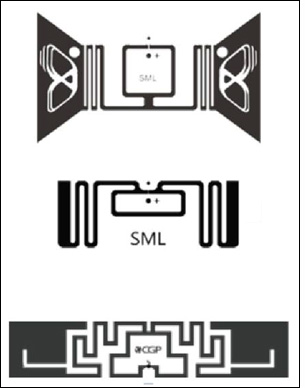SML Group Ltd. has opened a new inlay production center in Clayton, N.C., that is producing three new radio frequency identification inlays designed to enable the rapid growth of the company’s business in supplying RFID tags for the apparel industry. The family of three new EPC Gen 2 ultrahigh-frequency (UHF) RFID tags feature antenna designs intended to make the tags not only more sensitive to reads, but also faster to encode, thereby enabling SML Group to encode millions of tags in a very short span of time at its service bureaus worldwide.
The Maze inlay, manufactured with an NXP Semiconductors G2iL chip, measures 68 millimeters by 14 millimeters (2.75 inches by 0.55 inch) and has a sensitivity of -16 dBm (decibels per milliwatt). With a relatively long antenna, this model is designed for use on densely packed products.
The GB1 and GB2 inlays both come with an Impinj Monza 5 chip. The GB1 version measures 50 millimeters by 30 millimeters (1.97 inches by 1.18 inches), has a sensitivity of -17 dBm, and is designed for midsize label applications, such as those for sweaters or blouses. The GB2 model—the smallest inlay, at 40 millimeters by 15 millimeters (1.57 by 0.59 inches)—is designed for items requiring small tags, such as bras or shoes, with a sensitivity of -13 dBm, somewhat lower than that of the other two inlays. The Maze and GB1 versions have been tested and approved by the University of Arkansas’ RFID Research Center, while the GB2 has not yet been tested.
All three inlays are designed to meet the retail supply chain’s rapid growth in apparel tagging, says Philip Calderbank, SML Group’s VP of global RFID. The company, which acquired U.S. label manufacturer CPG Labels in July 2012 (see SML Group Buys CPG Labels), has been increasing its capacity for item-level RFID tag development and production, with a focus on the retail market. The new production center, which opened last month in Clayton, and a U.K. design and production center slated to open this summer in Corby, Northamptonshire, will help the company meet two goals: increasing its fast production of EPC tags for the apparel industry, and developing innovative designs for embedded woven tags, as well as tags for use on jewelry, cosmetics and bakeware. All projects are managed from the firm’s Hong Kong headquarters.
The three new inlays are intended not only to provide a more sensitive tag for end users, but also to speed up production for SML Group, Calderbank explains. “All of these tags compare favorably to anything in the market when it comes to read and write speed,” he says.
Writing and encoding speed, Calderbank adds, is becoming more important, as order size grows, along with the need for a fast turnaround time. SML Group employs service bureaus around the world to encode tags produced at SML’s facilities, thereby ensuring that turnaround time does not exceed 10 to 15 days. Potential bottlenecks, he notes, do not stem from trying to direct the tags to the proper geographic location, but rather from attempting to move them very quickly through the printing and encoding processes. With customers sometimes placing orders for tens of millions of tags, SML’s service bureaus are employing faster encoding techniques. The company has recently launched the use of high-speed machines at its service bureaus that can encode up to 180 labels per minute. As such, he says, the ability of write data to tags that quickly requires a sensitive chip and a well-designed antenna.
During the past year, SML Group has more than doubled its inlay sales for the apparel market, Calderbank reports. “We’re experiencing very strong growth,” he states.
The new design center will employ two senior engineers and three assistants. The Maze inlay was under development by CGP at the time of the July acquisition, while the GB1 and GB2 models followed and were designed in Hong Kong. The Maze is already in use by apparel suppliers, with the GB1 and GB2 versions just now coming into production, Calderbank says.


